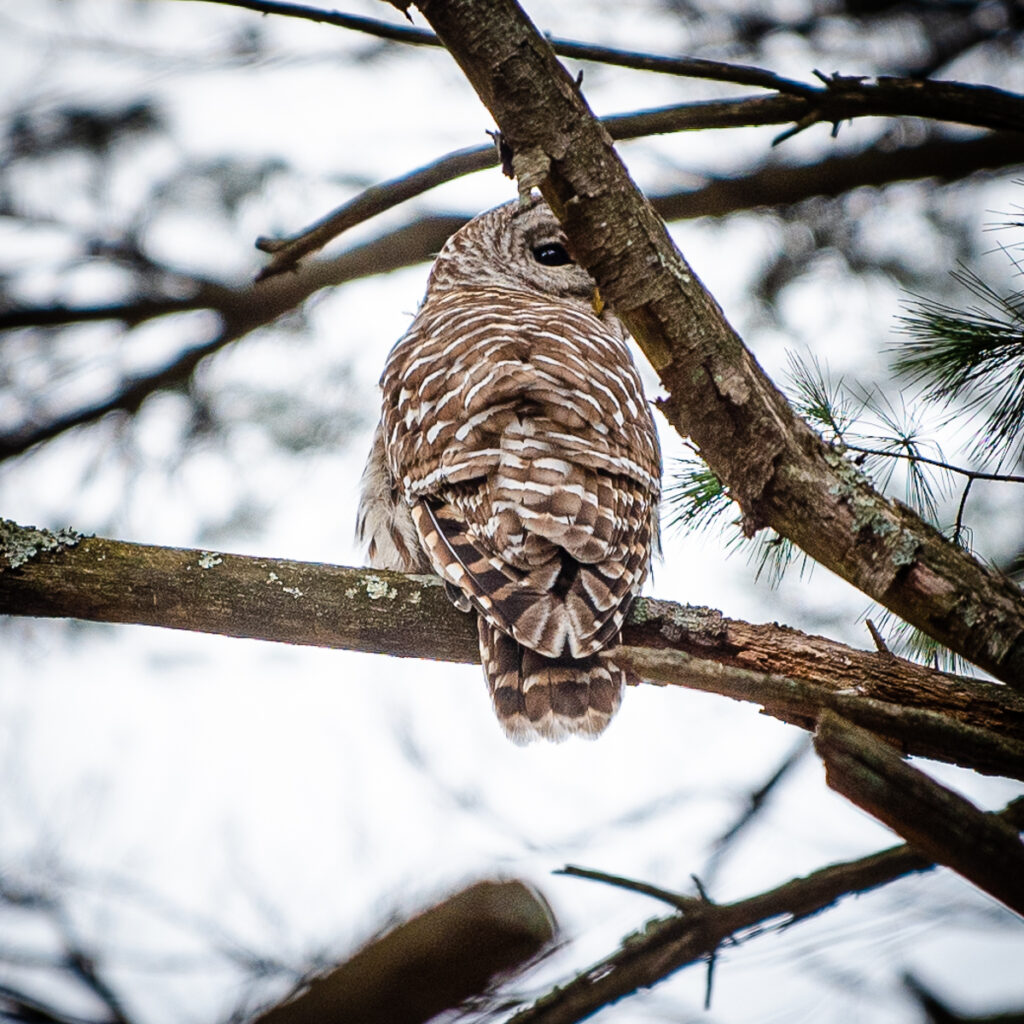
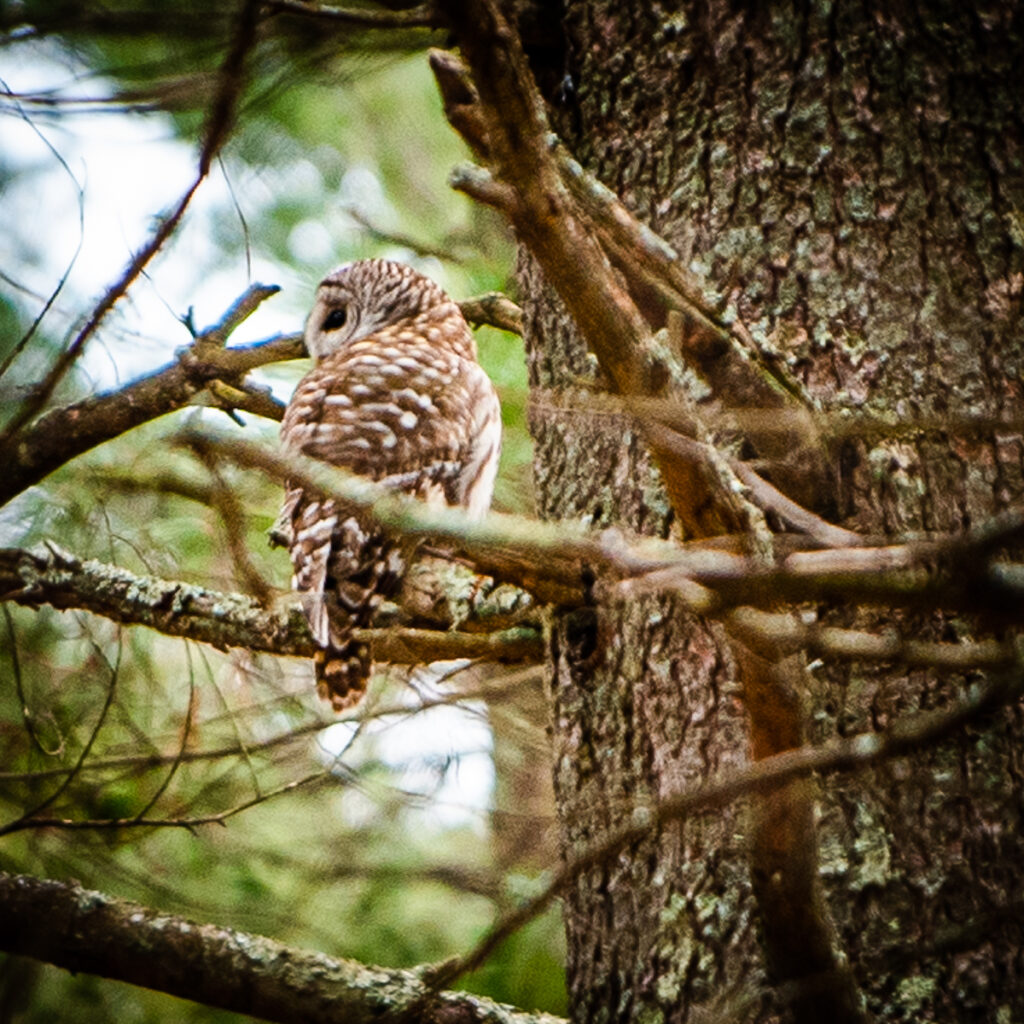
Out walking this afternoon and heard two barred owls hooting. Very distinctive call. So exciting! Thrilling to actually spot one of them during the day, and get a few shots.

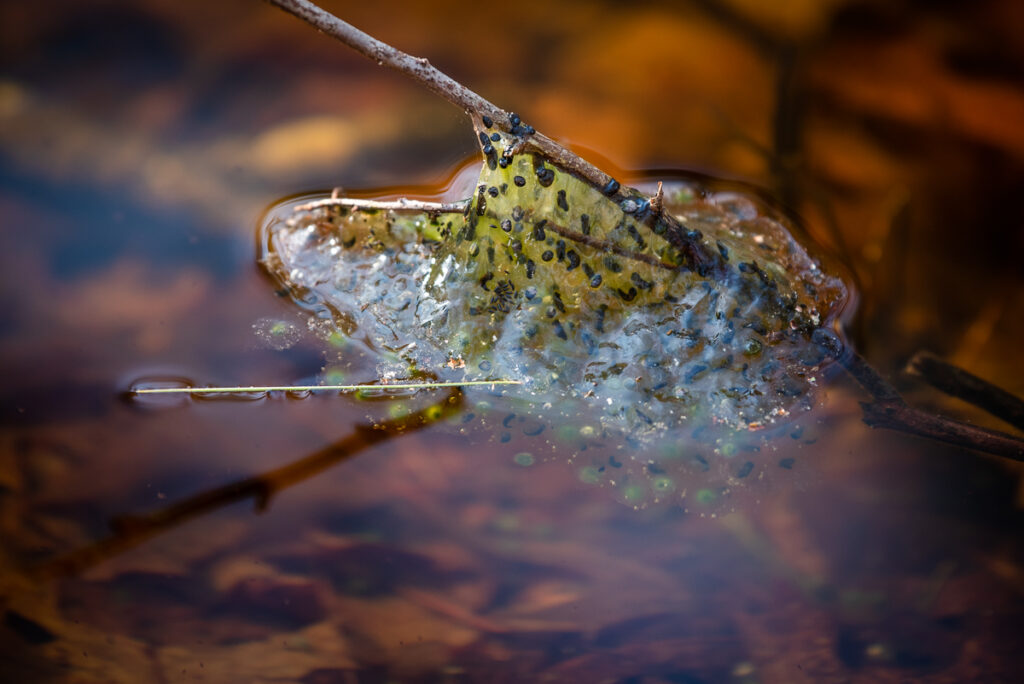
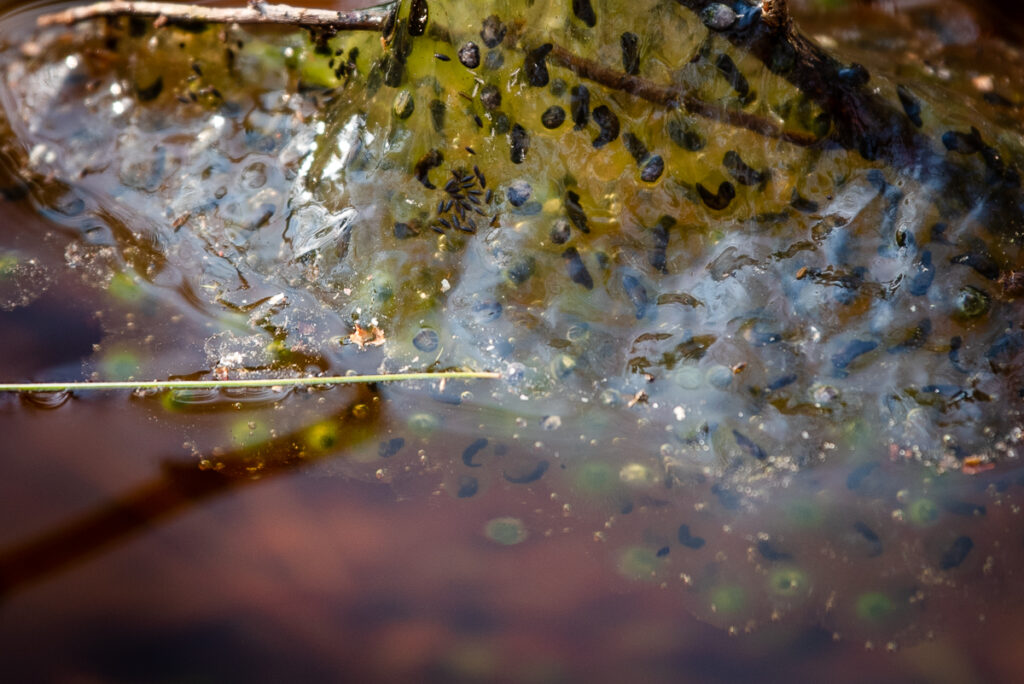
Even before the wildflowers get going, the peepers and wood frogs announce spring. (Wood frogs sound like ducks, or a bunch of loose banjo strings.) Usually I just listen… but this year I went on a vernal pool walk with a naturalist in Dover (organized by the Dover Open Space Committee).
I just loved having things pointed out to me that I have never noticed before, like gelatinous floating egg masses shimmering there on top of the water (eggs of wood frogs) and silvery translucent submerged masses (eggs of spotted salamanders).
So today I went looking in Needham for some egg clusters and I tell you, I did a lot of tromping with no luck, but did find this one and it’s pretty good. Before I would have thought it was just some algae/vegetation caught on that branch, but in the closeup you can see it’s a bunch of gelatinous ova containing black embryos, and some have turned into tiny tadpoles. (I’m pretty sure these are wood frog eggs, but let me know if not.) The egg mass is green with symbiotic algae; the babies stay with the egg mass feeding on the algae for a few days before dispersing into the pool.
Below is a phone shot I took on the vernal pools walk — wood frog eggs earlier in the cycle than my green shots above — newly laid, no one has hatched, and it hasn’t been colonized by algae. Vernal pools are temporary shallow pools that dry up after a couple of months– because of that, fish can’t live in them, and because of THAT, all kind of amphibians can lay their eggs in them without them being eaten by fish.
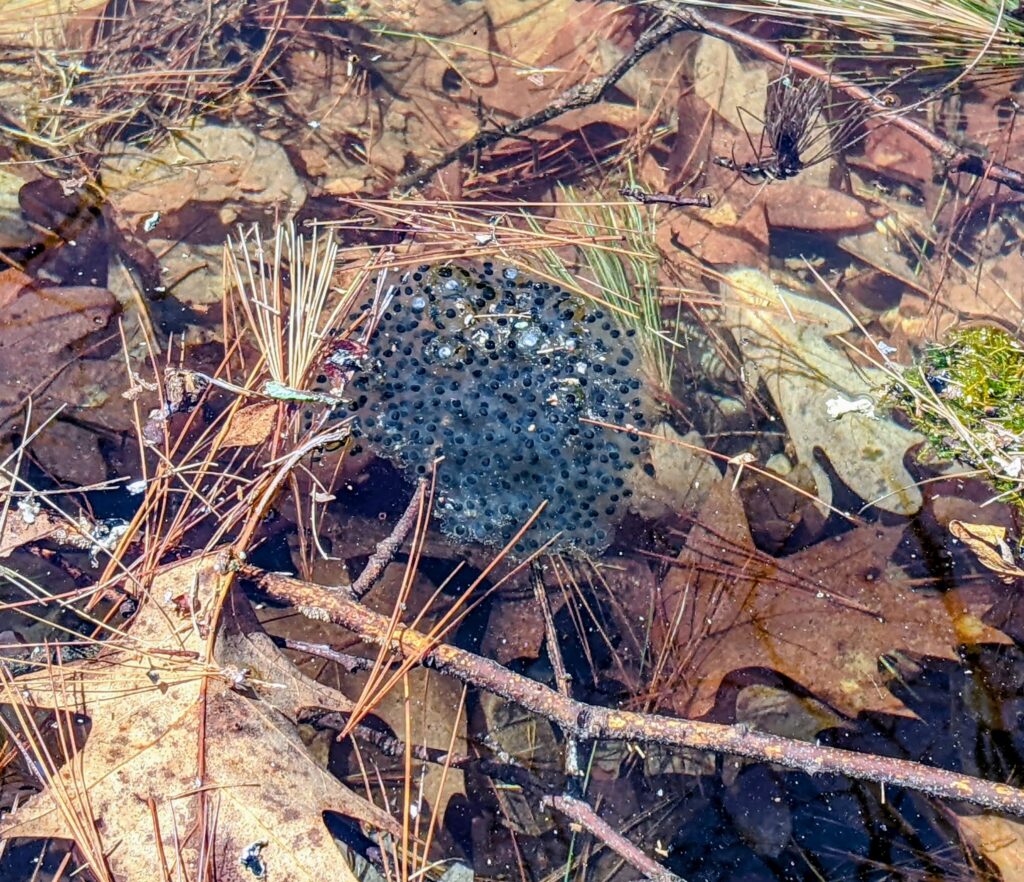
Wood frog (Rana sylvatica)
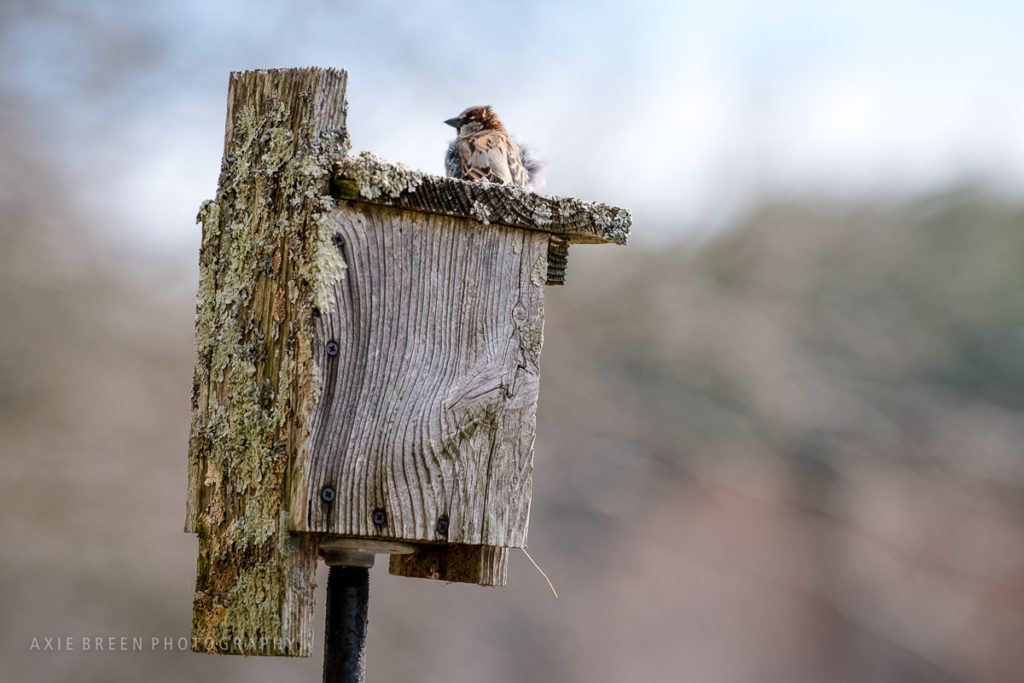
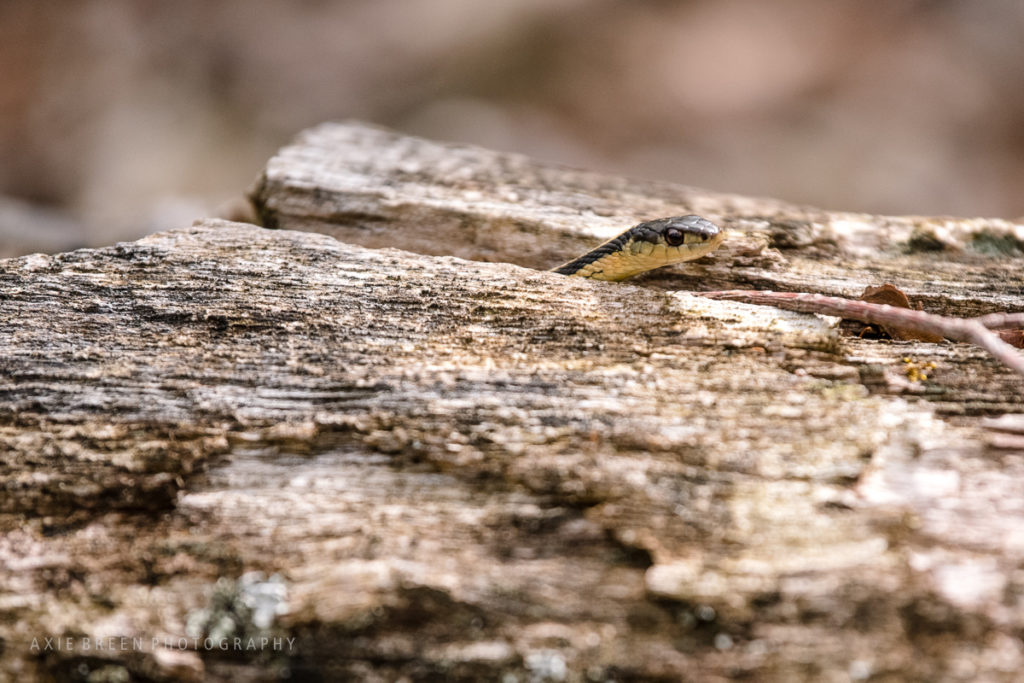
The only wildflower I’ve seen this spring is skunk cabbage, but a morning walk at Rocky Narrows (Sherborn MA) was so full of birdsong, it really felt like spring. Saw this little sparrow on its penthouse roof deck and also a few gartersnakes out catching rays.
Bonus video: The peepers are out and loud at Ridge Hill Reservation in Needham. Peepers are “chorus frogs,” and can live in breeding groups of several hundred. Their bodies can be less than an inch long or up to about 1.5 inches. It’s only the males that make the sound (to attract their women). They hibernate under logs and leaves, and can survive being mostly frozen. Then in spring, you hear them especially in vernal ponds and other temporary wetlands. They lay their eggs in the water, and then live on land the rest of the year, feeding on insects. You can also hear wood frogs in this video — they’re the ones that sound like ducks quacking, or loose banjo strings getting plucked.
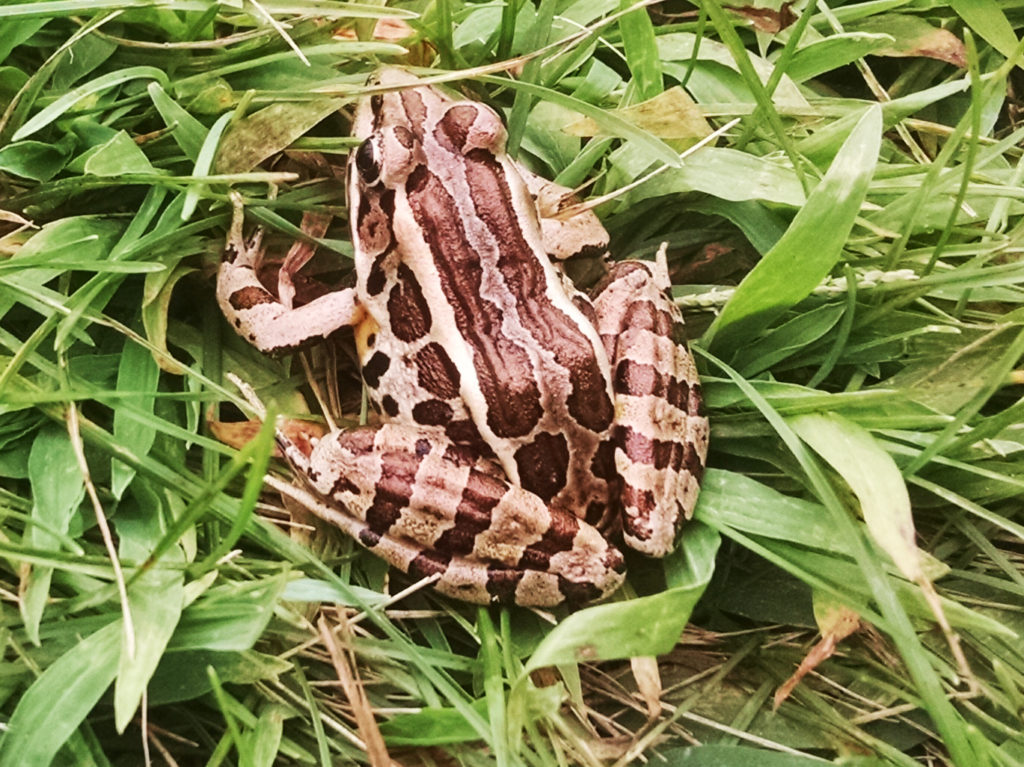 I haven’t posted in a long time because I hadn’t seen anything that I hadn’t already photographed, here in my narrow stomping grounds; I really covered a lot of wildflowers in my original fury of documentation. But today I saw two new wildflowers and this beautiful frog! The pickerel frog has front toes that are not webbed, making it more able to live on land apparently (and you can see the toes in this pic).
I haven’t posted in a long time because I hadn’t seen anything that I hadn’t already photographed, here in my narrow stomping grounds; I really covered a lot of wildflowers in my original fury of documentation. But today I saw two new wildflowers and this beautiful frog! The pickerel frog has front toes that are not webbed, making it more able to live on land apparently (and you can see the toes in this pic).
In winter they hibernate under debris in the water and come out for action from April to October. To catch their chow (insects, spiders, larvae), they will search grassy areas near their watery homes — like this frog, which was right on the trail, near the Charles River.
This is the only poisonous frog native to the U.S.! If attacked, it emits toxic skin secretions! However this does not deter its main predators: other kinds of frogs and snakes.
Pickerel frog (Lithobates palustris)
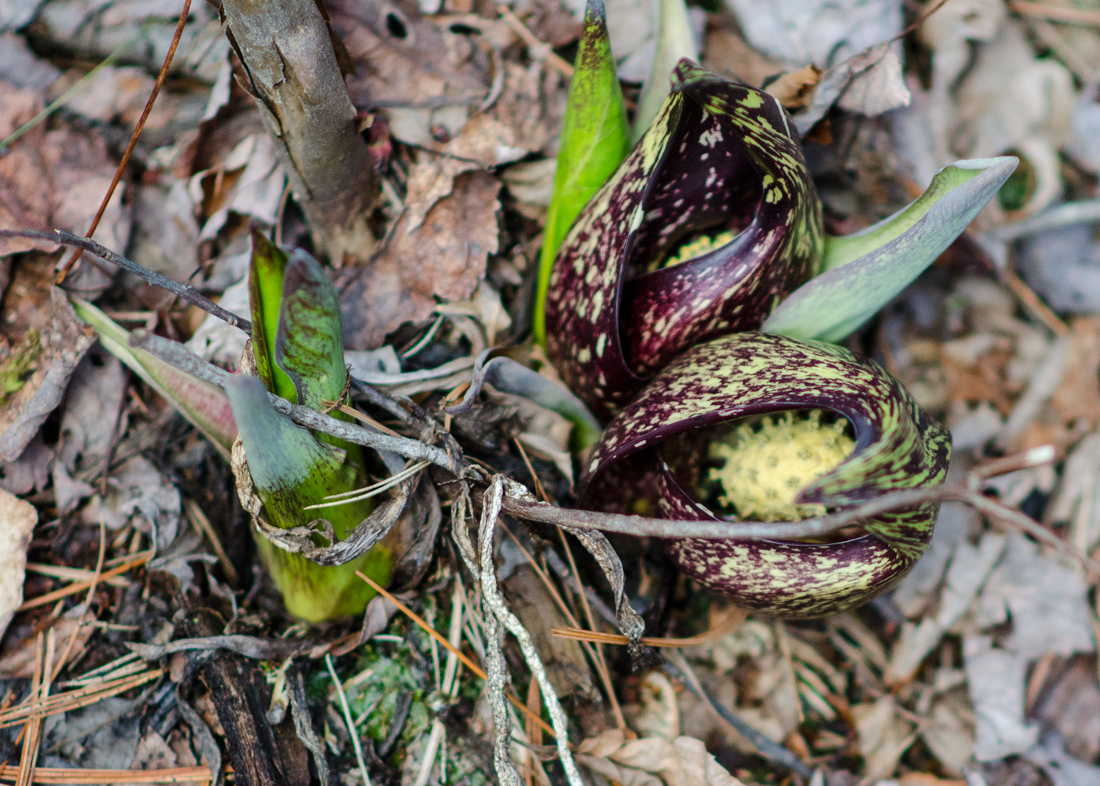 It was a mild winter. The skunk cabbage seemed to just survive the snow, with frost-blackened tips. In early April, creatures were waking up. Here, a skunk cabbage hood (spathe) showing the spadix inside (the flower head).
It was a mild winter. The skunk cabbage seemed to just survive the snow, with frost-blackened tips. In early April, creatures were waking up. Here, a skunk cabbage hood (spathe) showing the spadix inside (the flower head).
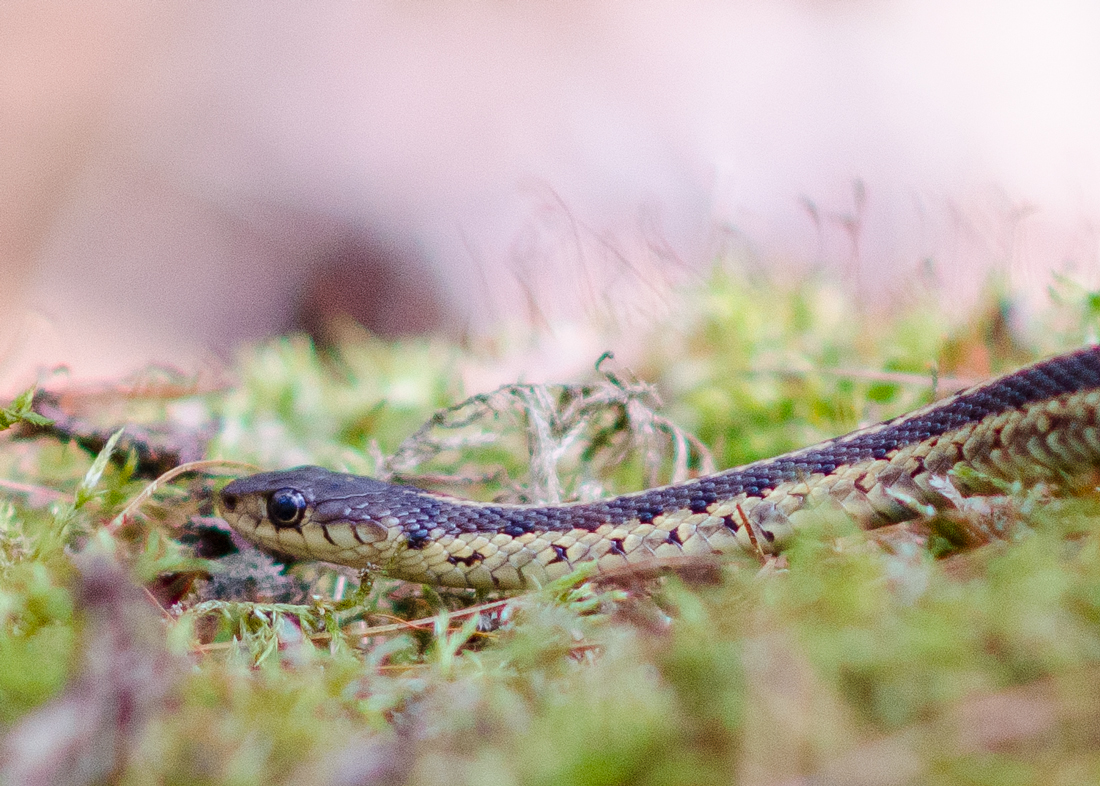 Also a garter snake adventuring, and best of all, there were a glorious few days of peepers. When I recorded this, they were so loud, and there were so many layers of sound, and individual voices. Wonderful. Not long after this, we had a spate of severe cold and snow and the peepers were noticeably quiet.
Also a garter snake adventuring, and best of all, there were a glorious few days of peepers. When I recorded this, they were so loud, and there were so many layers of sound, and individual voices. Wonderful. Not long after this, we had a spate of severe cold and snow and the peepers were noticeably quiet.
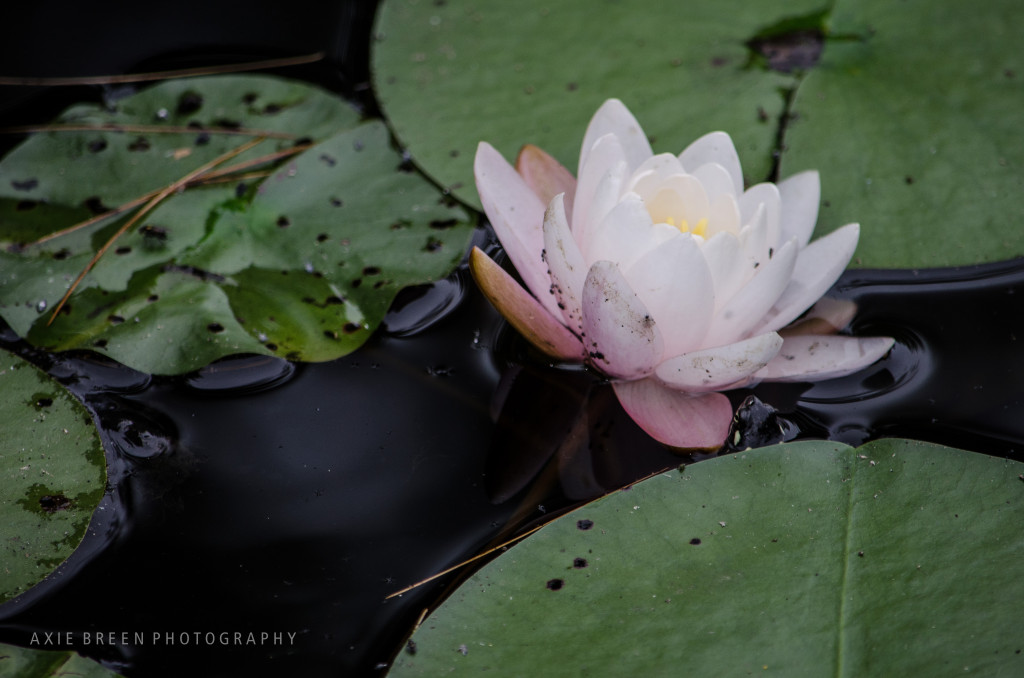 I photographed this lily, but look closely at who else is in this shot!
I photographed this lily, but look closely at who else is in this shot!
That’s right, a little frog has its nose stuck up there. And when we started looking for them, we saw loads of little frogs, still wearing their tadpole tails, enjoying their new ability to breath air, sunning themselves on the lily pads. (I can’t help but think, heron snacks.) I think these might be juvenile bullfrogs. There was a bullfrog at this pond with a call like a great foghorn.
Water Lily (Nymphaea sp.)
Bonus photo: Lucy investigating the beaver lodge, which is about twice as big as last year.
I wondered how this heron nest could possibly weather the severe winter we had, but I was glad to see it still there and occupied this spring. I believe these are the young ones, looking a bit like bowling pins til they turned their heads…
Herons lay 2-6 eggs in a clutch, in March and April. The eggs incubate about a month. Then they fledge when they’re about two months old. They still come back to visit for a few weeks.
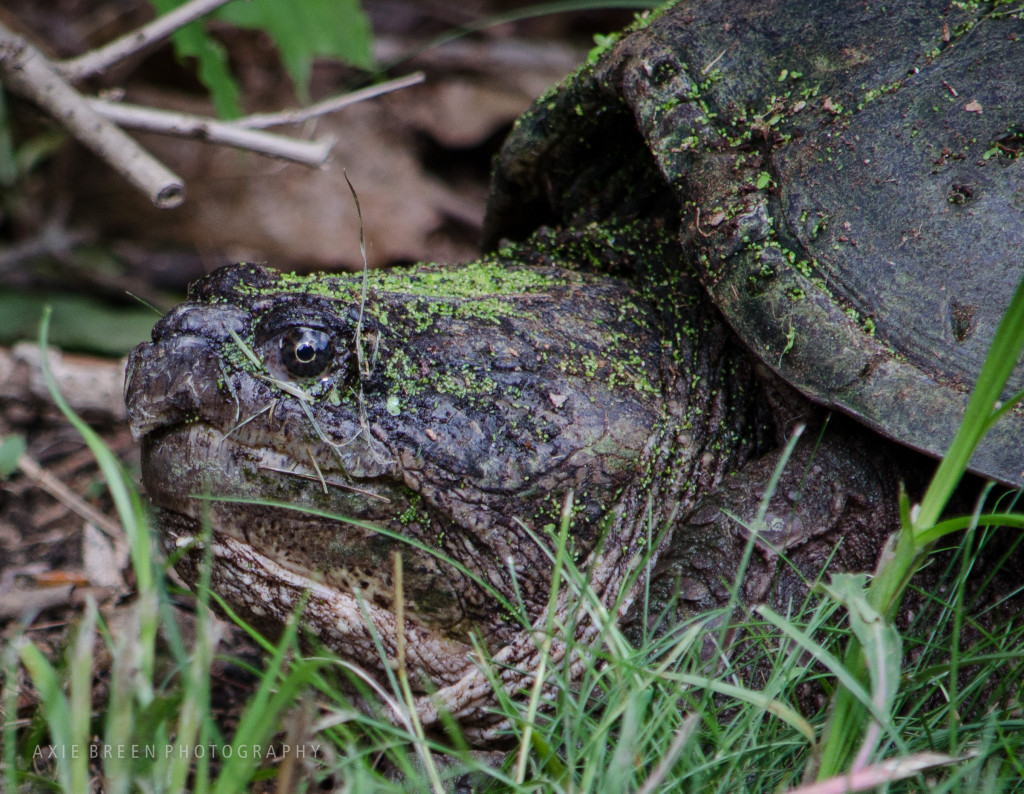 I was sitting at my desk when my attention was drawn by sudden movement outside. This turtle had just walked through the yard and when it came to the edge, where there’s a wall and a two-foot drop, it just took a
I was sitting at my desk when my attention was drawn by sudden movement outside. This turtle had just walked through the yard and when it came to the edge, where there’s a wall and a two-foot drop, it just took a flying leap tumble down to the driveway. Turtle parkour! At first I thought it might be injured, but it straightened its tunic and kept going. They’re surprisingly leggy and fast when in motion. Reminded me of this:
Presumably it was on an egg-laying mission.
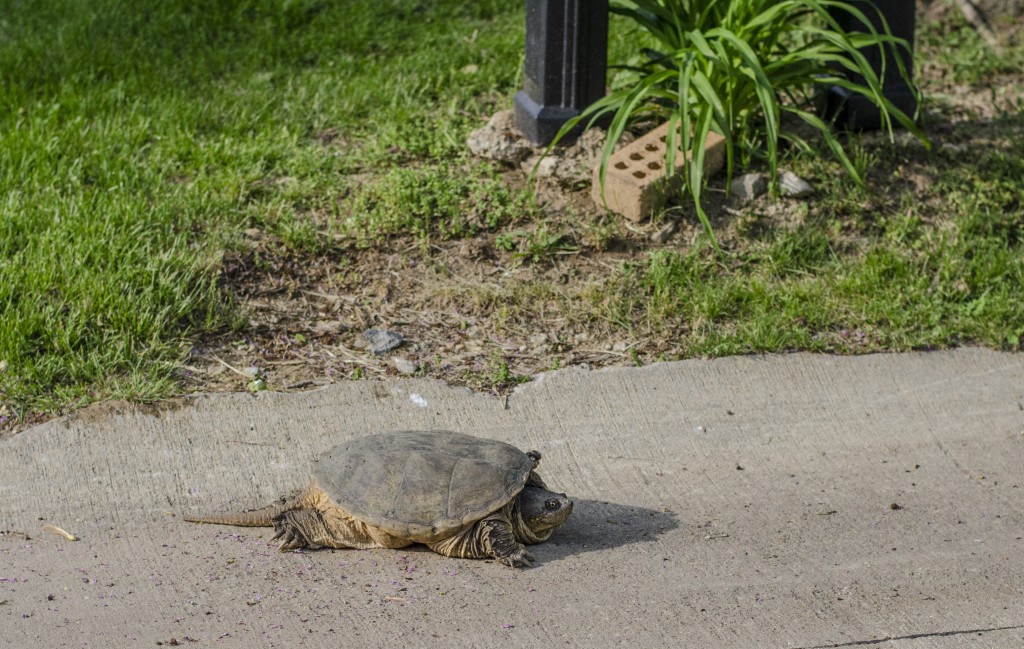
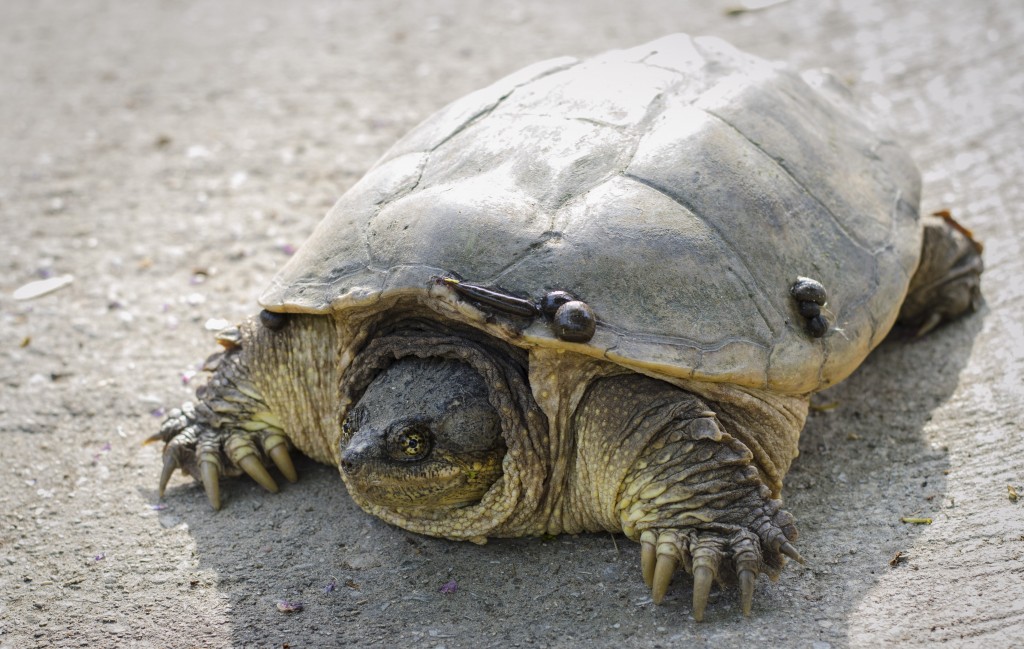 I was visiting my mom in Charleston, Illinois and looked out the window to see this snapping turtle motoring down the driveway at high turtle speed. Presumably it had laid eggs (somewhere in the yard? in the plowed field behind the house?) and was on its way back to the creek across the street. The neighbors came out to see what I was photographing. One of them was mowing his yard with a small end-loader. He came over, scraped the leeches off the turtle, picked it up by the tail and hauled it off to the creek. The turtle was pretty mad about this change in plans and got in some good snaps, but this way she didn’t have to cross the street. (I have since read that you shouldn’t pick them up by the tail because it can damage the spine and tail. Safest way for turtle and person is to grab the carapace above the back legs.)
I was visiting my mom in Charleston, Illinois and looked out the window to see this snapping turtle motoring down the driveway at high turtle speed. Presumably it had laid eggs (somewhere in the yard? in the plowed field behind the house?) and was on its way back to the creek across the street. The neighbors came out to see what I was photographing. One of them was mowing his yard with a small end-loader. He came over, scraped the leeches off the turtle, picked it up by the tail and hauled it off to the creek. The turtle was pretty mad about this change in plans and got in some good snaps, but this way she didn’t have to cross the street. (I have since read that you shouldn’t pick them up by the tail because it can damage the spine and tail. Safest way for turtle and person is to grab the carapace above the back legs.)
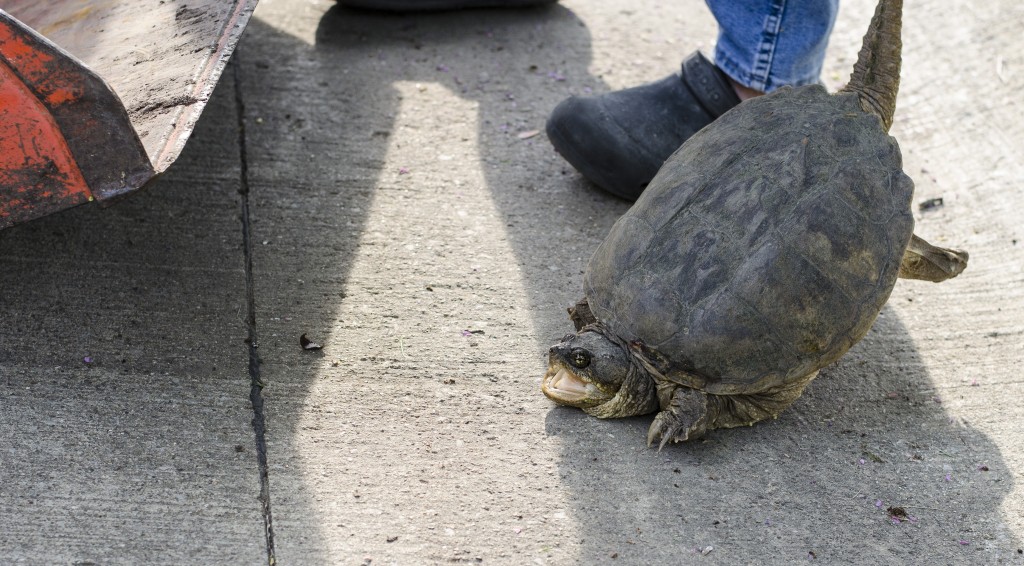
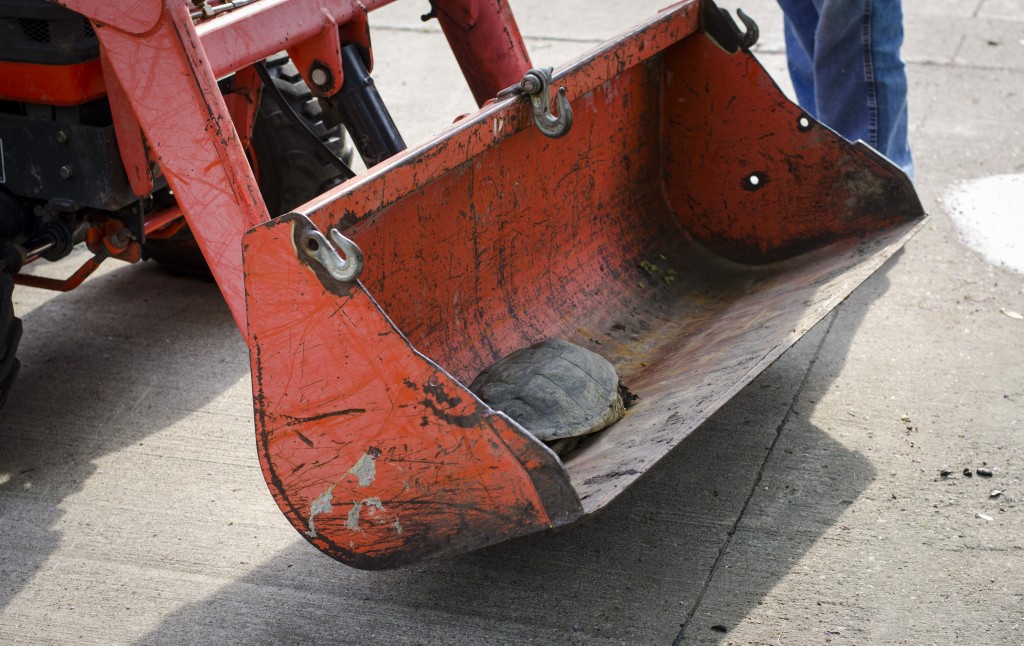 Snappers are known for their angry attitude, biting jaws and the fact that their heads can really extend and snake around for snapping you! They snap to defend themselves because they are too big to hide in their shells. In the north, they mature at 15-20 years and apparently can live over 100 years. Adults have few predators (besides humans) but almost everything likes to eat the eggs and hatchlings. Incubation time is 9-18 weeks, depending on how warm the weather is… so Mom’s neighborhood should be watching for hatchlings starting in early July.
Snappers are known for their angry attitude, biting jaws and the fact that their heads can really extend and snake around for snapping you! They snap to defend themselves because they are too big to hide in their shells. In the north, they mature at 15-20 years and apparently can live over 100 years. Adults have few predators (besides humans) but almost everything likes to eat the eggs and hatchlings. Incubation time is 9-18 weeks, depending on how warm the weather is… so Mom’s neighborhood should be watching for hatchlings starting in early July.
Common Snapping Turtle (Chelydra serpentina)
The only actual wildflower I’ve seen blooming is the skunk cabbage, but there are other signs of spring. The herons are back on their nest. And this robin had a bit of a bath! It looked so happy, dunking itself and flittering its wings. A blue jay shouldered its way in and this little one hopped out, but as soon as the jay had its drink and left, the robin popped back in.